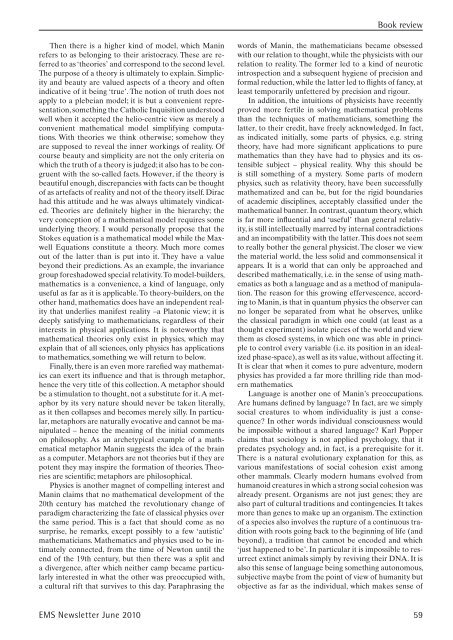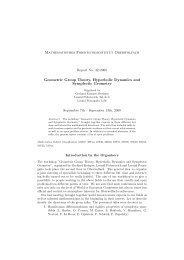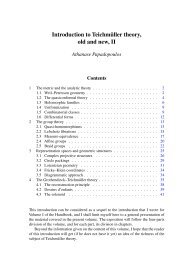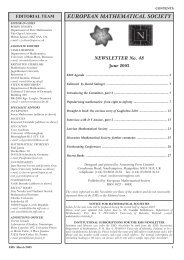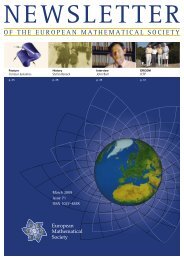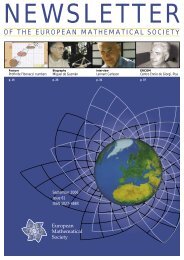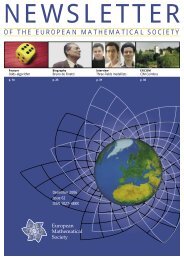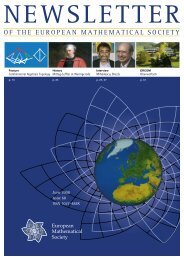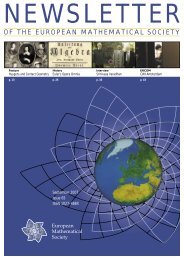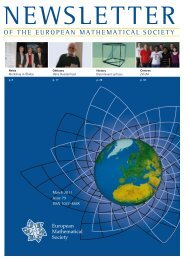EMS Newsletter June 2010 - European Mathematical Society ...
EMS Newsletter June 2010 - European Mathematical Society ...
EMS Newsletter June 2010 - European Mathematical Society ...
You also want an ePaper? Increase the reach of your titles
YUMPU automatically turns print PDFs into web optimized ePapers that Google loves.
Then there is a higher kind of model, which Manin<br />
refers to as belonging to their aristocracy. These are referred<br />
to as ‘theories’ and correspond to the second level.<br />
The purpose of a theory is ultimately to explain. Simplicity<br />
and beauty are valued aspects of a theory and often<br />
indicative of it being ‘true’. The notion of truth does not<br />
apply to a plebeian model; it is but a convenient representation,<br />
something the Catholic Inquisition understood<br />
well when it accepted the helio-centric view as merely a<br />
convenient mathematical model simplifying computations.<br />
With theories we think otherwise; somehow they<br />
are supposed to reveal the inner workings of reality. Of<br />
course beauty and simplicity are not the only criteria on<br />
which the truth of a theory is judged; it also has to be congruent<br />
with the so-called facts. However, if the theory is<br />
beautiful enough, discrepancies with facts can be thought<br />
of as artefacts of reality and not of the theory itself. Dirac<br />
had this attitude and he was always ultimately vindicated.<br />
Theories are definitely higher in the hierarchy; the<br />
very conception of a mathematical model requires some<br />
underlying theory. I would personally propose that the<br />
Stokes equation is a mathematical model while the Maxwell<br />
Equations constitute a theory. Much more comes<br />
out of the latter than is put into it. They have a value<br />
beyond their predictions. As an example, the invariance<br />
group foreshadowed special relativity. To model-builders,<br />
mathematics is a convenience, a kind of language, only<br />
useful as far as it is applicable. To theory-builders, on the<br />
other hand, mathematics does have an independent reality<br />
that underlies manifest reality –a Platonic view; it is<br />
deeply satisfying to mathematicians, regardless of their<br />
interests in physical applications. It is noteworthy that<br />
mathematical theories only exist in physics, which may<br />
explain that of all sciences, only physics has applications<br />
to mathematics, something we will return to below.<br />
Finally, there is an even more rarefied way mathematics<br />
can exert its influence and that is through metaphor,<br />
hence the very title of this collection. A metaphor should<br />
be a stimulation to thought, not a substitute for it. A metaphor<br />
by its very nature should never be taken literally,<br />
as it then collapses and becomes merely silly. In particular,<br />
metaphors are naturally evocative and cannot be manipulated<br />
– hence the meaning of the initial comments<br />
on philosophy. As an archetypical example of a mathematical<br />
metaphor Manin suggests the idea of the brain<br />
as a computer. Metaphors are not theories but if they are<br />
potent they may inspire the formation of theories. Theories<br />
are scientific; metaphors are philosophical.<br />
Physics is another magnet of compelling interest and<br />
Manin claims that no mathematical development of the<br />
20th century has matched the revolutionary change of<br />
paradigm characterizing the fate of classical physics over<br />
the same period. This is a fact that should come as no<br />
surprise, he remarks, except possibly to a few ‘autistic’<br />
mathematicians. Mathematics and physics used to be intimately<br />
connected, from the time of Newton until the<br />
end of the 19th century, but then there was a split and<br />
a divergence, after which neither camp became particularly<br />
interested in what the other was preoccupied with,<br />
a cultural rift that survives to this day. Paraphrasing the<br />
Book review<br />
words of Manin, the mathematicians became obsessed<br />
with our relation to thought, while the physicists with our<br />
relation to reality. The former led to a kind of neurotic<br />
introspection and a subsequent hygiene of precision and<br />
formal reduction, while the latter led to flights of fancy, at<br />
least temporarily unfettered by precision and rigour.<br />
In addition, the intuitions of physicists have recently<br />
proved more fertile in solving mathematical problems<br />
than the techniques of mathematicians, something the<br />
latter, to their credit, have freely acknowledged. In fact,<br />
as indicated initially, some parts of physics, e.g. string<br />
theory, have had more significant applications to pure<br />
mathematics than they have had to physics and its ostensible<br />
subject – physical reality. Why this should be<br />
is still something of a mystery. Some parts of modern<br />
physics, such as relativity theory, have been successfully<br />
mathematized and can be, but for the rigid boundaries<br />
of academic disciplines, acceptably classified under the<br />
mathematical banner. In contrast, quantum theory, which<br />
is far more influential and ‘useful’ than general relativity,<br />
is still intellectually marred by internal contradictions<br />
and an incompatibility with the latter. This does not seem<br />
to really bother the general physicist. The closer we view<br />
the material world, the less solid and commonsensical it<br />
appears. It is a world that can only be approached and<br />
described mathematically, i.e. in the sense of using mathematics<br />
as both a language and as a method of manipulation.<br />
The reason for this growing effervescence, according<br />
to Manin, is that in quantum physics the observer can<br />
no longer be separated from what he observes, unlike<br />
the classical paradigm in which one could (at least as a<br />
thought experiment) isolate pieces of the world and view<br />
them as closed systems, in which one was able in principle<br />
to control every variable (i.e. its position in an idealized<br />
phase-space), as well as its value, without affecting it.<br />
It is clear that when it comes to pure adventure, modern<br />
physics has provided a far more thrilling ride than modern<br />
mathematics.<br />
Language is another one of Manin’s preoccupations.<br />
Are humans defined by language? In fact, are we simply<br />
social creatures to whom individuality is just a consequence?<br />
In other words individual consciousness would<br />
be impossible without a shared language? Karl Popper<br />
claims that sociology is not applied psychology, that it<br />
predates psychology and, in fact, is a prerequisite for it.<br />
There is a natural evolutionary explanation for this, as<br />
various manifestations of social cohesion exist among<br />
other mammals. Clearly modern humans evolved from<br />
humanoid creatures in which a strong social cohesion was<br />
already present. Organisms are not just genes; they are<br />
also part of cultural traditions and contingencies. It takes<br />
more than genes to make up an organism. The extinction<br />
of a species also involves the rupture of a continuous tradition<br />
with roots going back to the beginning of life (and<br />
beyond), a tradition that cannot be encoded and which<br />
‘just happened to be’. In particular it is impossible to resurrect<br />
extinct animals simply by reviving their DNA. It is<br />
also this sense of language being something autonomous,<br />
subjective maybe from the point of view of humanity but<br />
objective as far as the individual, which makes sense of<br />
<strong>EMS</strong> <strong>Newsletter</strong> <strong>June</strong> <strong>2010</strong> 59


